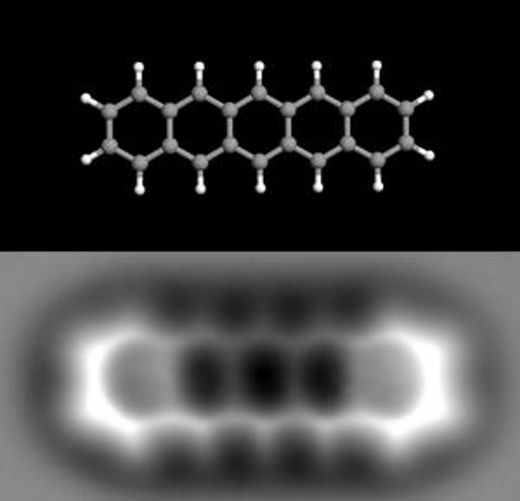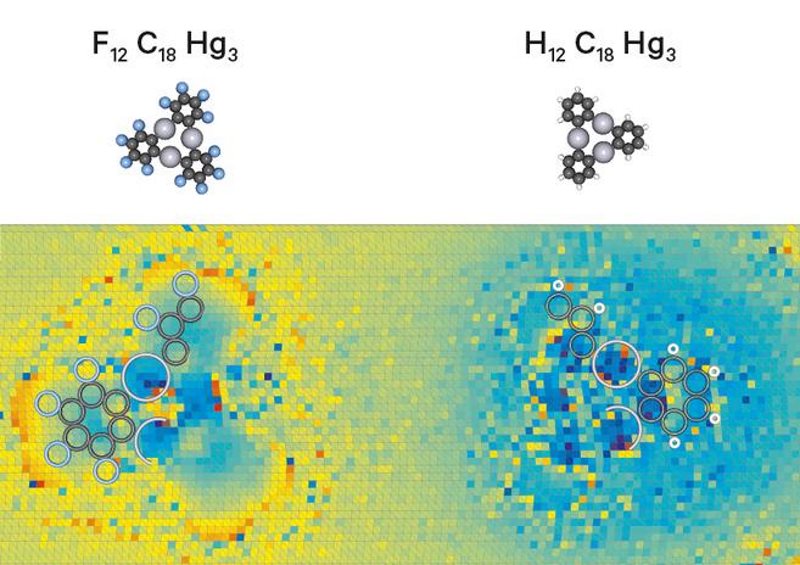
- Researchers used a technique known as Kelvin probe force spectroscopy
- It used fine probe to measure the minute electric forces around atoms
- This allowed them to unpick what the bonds between atoms look like
- Scientists usually rely upon theoretical models to understand these bonds
Scientists have managed to visualise the electron clouds that form covalent chemical bonds between atoms to hold molecules together. Two hydrocarbon molecules are shown in the image above with the position of the atom nuclei superimposed on top of the image
Until now it has only been possible to guess at what these structures looked like in molecules using theoretical models.
But a group of researchers have applied a pioneering technique, which uses an incredibly precise probe, to visualise the bonds between atoms.The technique allowed the scientists to probe the charge of an individual atom and distinguish different types of chemical bonds.
As not all electrons are shared equally between atoms, it can often result in them developing electrical charges known as polarity.
The technique, which used a metal probe with a point so fine it is tipped with a single molecule of carbon monoxide, can observe subtle imbalances in the bond between atoms.
Writing in the journal Physical Review Letters, Dr Pavel Jelinek, a physicist who led the research at the Institute of Physics of the Czech Academy of Science, said: 'It enables one to obtain charge-related maps at even closer tip-sample distances, where the lateral resolution is further enhanced.
'This enhanced resolution allows one to resolve contrast variations along individual polar bonds.'
Working with Professor Jascha Repp, a physicist at the University of Regensburg, Dr Jalinek and his team built on a technique used in 2009 to make out individual atoms in a molecule.
The technique, called Kelvin probe force spectroscopy, uses a probe which scans across the surface of a molecule like a 'finger' to reveal its atomic structure.It revealed the atoms formed a surprising structure much like the stick and ball images used in school chemistry lessons.
However, to see tiny and fast moving electrons that are shared by the atoms in such a molecule, the researchers needed to alter the approach.By looking at how the probe moves due to minute electrostatic charges in the atom, the scientists were able to view the bonds between the atoms.The researchers used their probe to examine the bonds of two hydrocarbon molecules (pictured)
The result is a series of colourful pictures that show not only the nucleus of the atoms themselves but the cloud of electrons around them.

This allowed them to unravel the effect of the electron cloud from the other forces that may act on the probe, such as the weak van der Waals attraction which can draw molecules with charged atoms closer together.
The researchers found in their hydrocarbon moelcules that electron clouds appear to concentrate around fluorine atoms, much as the theory suggests they would. They say the technique could help to develop better solar cells by examining how electrons respond in molecules when they are exposed to sunlight.
Speaking to Cosmos Magazine Dr David Hoxley, a physicist at La Trobe University who was not involved in the research, said the approach was 'pretty amazing'.
He said: 'If you told chemists about this 20 years ago they would've given you 10,000 different reasons why you couldn't do it.'
References:
Phys. Rev. Lett. 115, 076101 (2015) - Probing Charges on the Atomic Scale by Means of Atomic Force Microscopy



Reader Comments
to our Newsletter